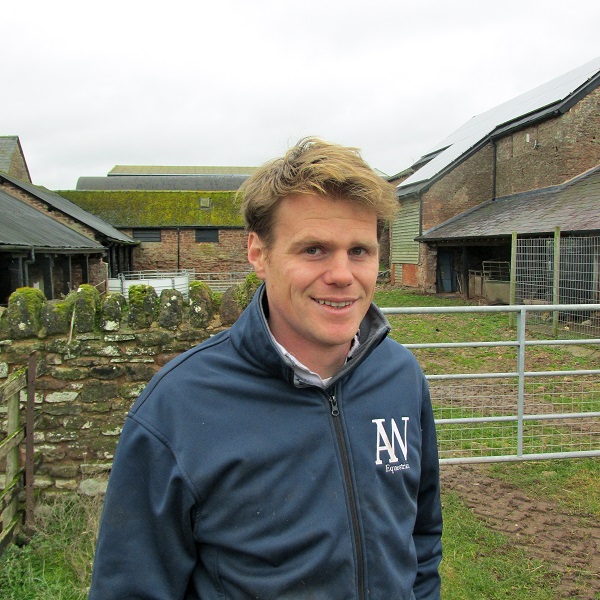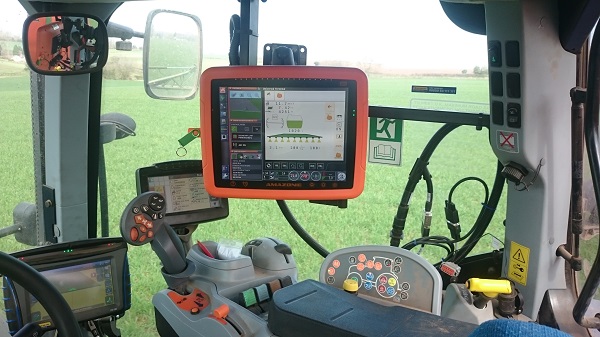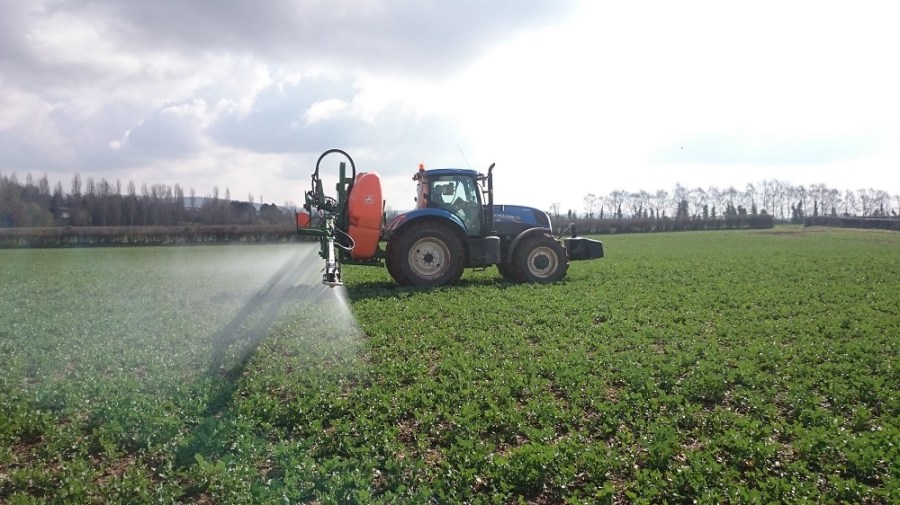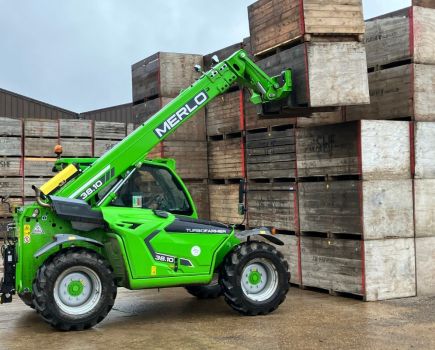After taking over the tenancy of Weir End Farm from his father in 2012, one of the first decisions Alastair Hunter Blair made was to invest in a Amazone UF 1801 sprayer. CPM went to find out how has it been measuring up.
In its first season, the sprayer brought about an 8% saving in chemicals and no part of any field was missed.
By David Jones
Situated either side of the A40 to the west of Ross-on-Wye, Herefordshire, Weir End Farm is one of three outlying holdings forming part of the Duchy of Cornwall’s estate to the north and extends to 200ha. For the past five years, it’s been run by Alastair Hunter Blair, a progressive young farmer keen to take advantage of the many advances in agricultural engineering and technology – but not at any cost.
The farm forms part of The Guy’s Estate – the Duchy of Cornwall’s historic land holdings in Herefordshire, around 500ha of which is woodland. The remaining 4100ha is predominantly Grade 2 farmland, extending from just north of Hereford down to Ross-on-Wye. More recently, the Duchy acquired the nearby Cradley Estate, adding another 750ha of mostly Grade 3 land.

Alastair Hunter Blair believes machine replacements should be selected on merit, rather than tradition.
Alastair’s business is run in co-operation with two neighbouring farmers, together totalling 400ha, one of which is predominantly a fruit grower, the other a dairy unit. Most machinery is individually owned, but some of the larger pieces of kit are shared according to demand.
So was it brand loyalty or farm tradition that led Alastair back to Amazone when replacing the farm’s sprayer? “We did look at alternatives, but one thing I was quite specific about was to move from 18m up to 24m. We had just signed up for RTK positioning technology and wanted to take full advantage of the auto shut-off feature that the UF 1801 offered,” he explains.
In short, the results were astounding, according to both Alastair and the farm’s long-serving operator, Graham Davies. “In its first season, the sprayer brought about an 8% saving in chemicals and no part of any field was missed,” Alastair recalls.
“It was a real eye-opener for me, and Graham, too, found it hard to believe. None of our fields are square and we have banks, so the initial outcome was even more surprising.”
Much of the credit for this economy and accuracy is given to the then new AmaPad operator terminal, developed by Amazone as an aid to GPS-guided precision farming applications such as part-width section control. The 12in (30cm) screen incorporates a ‘mini-view’ facility that allows the operator to monitor applications that don’t yet need to be activated.
Operators can also customise the AmaPad by, for example, enlarging the detail using finger-tip widening, while in addition to the part-width section control there’s a light-bar guidance display. Alastair is very pleased that he included this alternative to the previous Amatron screen in his specification for the 1801– even at an additional cost of around £2000.
“Once the sprayer’s turned on, it just maps where it’s been so you can see how much you’re saving. It’s a really good bit of kit,” he adds. “In effect, the AmaPad controls the sprayer while the tractor is in charge of the steering.”

The AmaPad control terminal option on the UF 1801 is well worth the upgrade cost, Alastair insists.
Another significant consideration – one of practicality and safety – was the fact that the UF 1801 has booms that fold backwards. Weir End Farm is bisected by the busy A40 dual carriageway, the crossing of which can be tricky enough even with a clear view both ways, so a rearward-folding sprayer ticked another box for Alastair.
“When we were deciding on the set up and specification, we went for nine sections over 24m, in a 4-4-6-6-8-6-6-4-4 nozzle format, with the two outside sections much smaller – to save money,” he recalls. “The Amazone was pivotal to us in terms of the design of the booms, not only for reasons of road transport, but also the fact that our average field size is only 3.5-4ha.
“We’d love to have had individual nozzle-switching, but couldn’t justify the additional cost. Having said that, we’re very happy with the way it works as it is.”
On spraying days, Alastair finds the UF 1801 very user-friendly. “The control panel on the side of the sprayer is very easy to use with gloves on,” he reports. “It’s also clearly laid out, with three valves controlling all of the functions, from filling to spraying.
“The tank wash is very thorough and we never have any problems with chemical residue when switching crops. If there’s one downside, it’s that the AmaPad – at the start of the day – can think it’s in reverse and therefore at the front of the tractor. However, once you get into the habit of double checking before you set off, it ceases to be an issue.”
Boom stability, he says, is very good, giving the operator the confidence to keep the booms low, even on Weir End’s sloping fields. “It’s a simple, accurate, well built machine – and I can’t ask for more than that,” is his considered opinion.
Praise is also directed at Pallisers, the dealership for Amazone machinery locally. Based at the company’s Yarkhill depot, near Hereford, technician Liam McSherry’s input in particular is always much appreciated. “If there’s a problem,” Alastair states, “Liam won’t sleep until he’s sorted it.”
Spraying for diverse cropping
On the surface, it might seem slightly unusual for sugar beet to still have a place in the rotation at Weir Side Farm but there are still stalwarts growing the crop in this corner of the country. Some gave up when British Sugar closed its Kidderminster factory and most of the rest followed suit on the closure of Allscott, near Telford, leaving Newark the closest point of delivery.
Although these days grown on a much smaller scale here, demand for beet now comes from several anaerobic digester plants in the west. “Sugar beet grows for fun on our soils. Good yields – not far off 100t/ha last year – can be achieved and so clean on lifting that the AD boys often don’t even need to wash it,” comments Alastair.
Mild surprise greeted an approach made to the farm by British Sugar last year in which an increase in the delivery subsidy to outlying growers was offered. But although this fell a long way short of being a viable proposition, the farm is looking to increase the acreage devoted to the crop anyway.
One downside of these sandy, beet-friendly soils, however, is the speed at which implement shares, blades and tines wear. “We’re trying to use the plough less and less, min-tilling most autumn crops now before combi-drilling,” Alastair states. “It had got to the stage when we were virtually having to rebuild the plough every season.”
Soya beans, grown for the first time in 2017, also look as though they have a future here. “They produced a better gross margin than peas,” Alastair reports, “and they seem to do well in the light intensity and soil temperatures that prevail in the Wye Valley. And with the vast majority of soya beans grown globally being genetically modified, there seems to be a bit of a niche market for non-GM soya. Food retailers like Waitrose, for example, would probably confirm that.”
Amazone UF 1801: top features
Two generations of a farming family have established a four-in-a-row history of a specialist machine built by the same manufacturer, which would suggest a degree of satisfaction. Here’s some detail of those UF 1801’s features highlighted by Alastair.
- Easy to attach and connect to the tractor with a few hand clamps and sufficient space between tractor and sprayer to manoeuvre into position.
- The AmaPad terminal allows for the keys of an existing AUX-N compatible multi-function joystick to be re-programmed to suit individual preferences.
- Piston diaphragm pumps are able to run dry and are liquid fertiliser proof. Constant monitoring from the cab is possible, as the pump’s oil volume equaliser is in view of the operator.
- Liquid delivery for filling the sprayer is carried in such a way that clear water is always available in the induction bowl.
- All sprayer functions have just three operating elements: vario-control pressure for filling, inducting, spraying and cleaning -inside and out; rapid emptying of the spray agent tanks; vario control suction cleaning of tanks.
- Three-fold damping suspension for challenging operating conditions.
- Automatic electro-hydraulic tilt and return adjustment of the boom to allow consistency of application on hilly or uneven ground.
- The Super S2 boom folds completely and automatically to sit unobtrusively behind the tank to create a transport width of 2.4m.
Farm Facts
Weir End Farm, Ross-on-Wye, Herefordshire
- Size: 200ha
- Soil types: very light Ross sand, some River loam, very easy-working
- Crops grown: a five-year rotation (key to keeping blackgrass out) comprising oilseed rape, winter wheat, barley, soya or peas, sugar beet
- Livestock: small flock (currently 70-strong) of Easycare ewes – Wiltshire Horn x Lleyn x Beltex
Owned machines
- Mainline tractors: 2017 New Holland T7.210, T7.200
- Loader: 2011 Manitou MLT634
- Sprayer: Amazone UF 1801 24m
- Drills: 4m Kuhn Megant; 3m Kuhn combination
- Cultivation: 3m Simba Xpress with ST bar; 5f Lemken Juwel 7 plough; Spaldings stubble cultivator
Shared machines
- Combine: 2012 New Holland CX5090
- Fertiliser spreader: Amazone ZA-TS
- Other: 6m Twose Cambridge rolls; Bomford hedgecutter; Teagle topper




